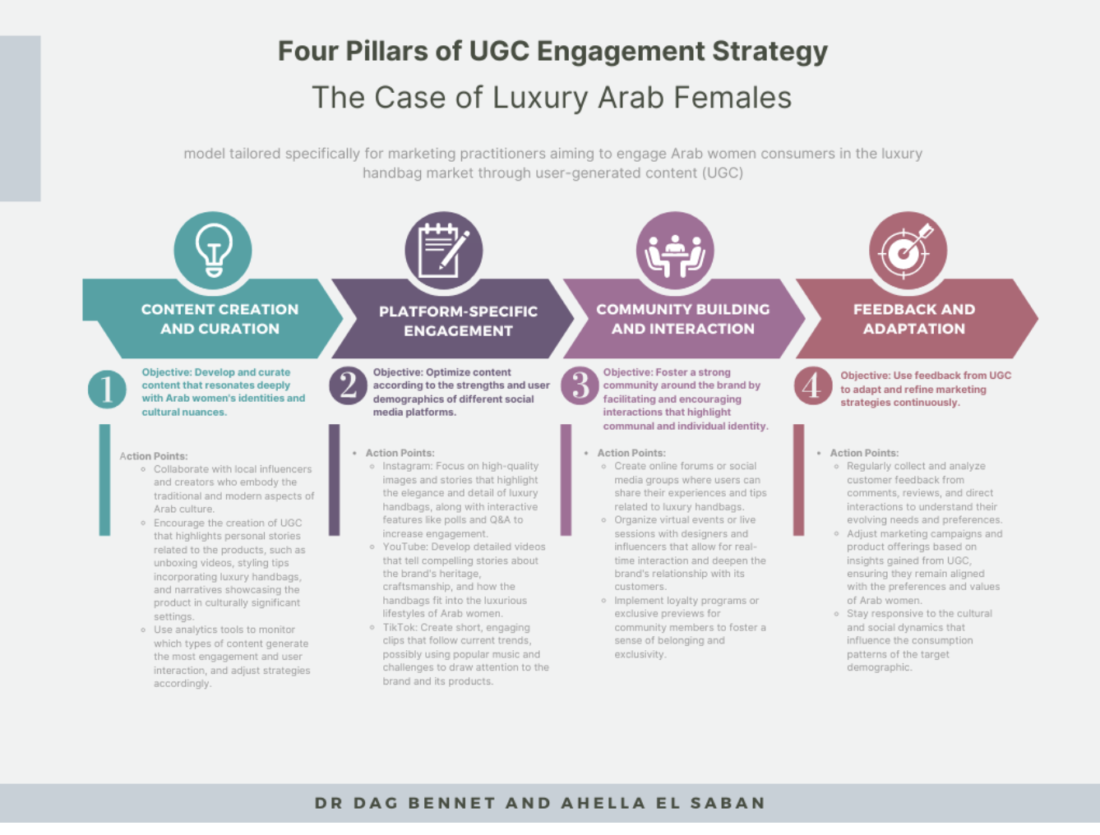Navigating The Digital Silk Road: Arab Women, Luxury Handbags, And The Power of User-Generated Content
Co-authored by: Ahella El Saban, Co-founder and Vice Chairman of Exits and Dr. Dag Bennett, Director of the Ehrenberg Centre for Research in Marketing at London South Bank University


Introduction:
The digital transformation of marketing can be seen in the content (UGC) created by Arab women about their intricate relationships with their handbags. In this article, we present research that used over 800 individual examples of UGC touchpoints in online communities to map out the interplay of consumer identity, brand perception, and digital interaction.
The Arab Female Consumer: A Complex Tapestry:
As key consumers, Arab women are redefining luxury marketing. We looked at their motivations and desires for empowerment, exclusivity, and beauty, where owning high-end products is deeply rooted in the desire to express the inner and outer self, and consumption reflects cultural pride, empowerment, and a passion for social recognition. These new insights allow marketers to align themselves with their key customers better.
1. Inner and Outer Selves:
– Arab women’s engagement with luxury handbags reflects a dialogue between their internal desires and external expressions. The handbag is more than an accessory; it’s a statement of who they are and aspire to be. It expresses tastes, social status, and cultural values; a luxury handbag demonstrates personal success, artistic aesthetics, and fashionability.
2. Identity Constructs and UGC:
The UGC platform enables Arab women to post their thoughts, photos and videos, showcase their style and negotiate their roles in their communities and society. Sharing and engaging on social media platforms is not just about swanking (though that may be part of it). It’s also a form of nuanced self-expression and communal interaction. This study shows how UGC can reveal the luxury market’s core buyer/seller dynamics.
3. Community and Individuality:
With UGC, Arab women find a space to connect with other women. This communal aspect is not just about individual expression but about being part of a community where luxury handbags become symbols of shared tastes, common aspirations, and mutual experiences.
Our research reveals UGC as a lens to examine female identity and its pivotal role in consumer behaviour. Practically, we provide actionable insights for luxury brands, highlighting the need for visually and culturally literate marketing that chimes with the complex and evolving identities of Arab women.
UGC: The New Marketplace dynamic:
UGC is emerging as a transformative force in luxury, especially in regions like the UAE, where Dubai accounts for more than 30% of all luxury sales. The rise of UGC reflects changing consumer behaviours and preferences, particularly post-COVID.
In luxury, UGC can be seen as a dichotomy between brands and consumer communities, where Arab women express themselves, form communities, and make purchase decisions. User-led content creation impacts brand perceptions and brand equity, marking a shift from relying on traditional advertising to relying more on authentic stories in UGC. The implication is that luxury marketers can evolve from marketing interventions to brand community participation.
1. The Blossoming of Luxury Marketing:
UGC has exploded in recent years, partly because consumers want to share experiences and opinions online and have become good at it. In the context of luxury brands, UGC is a powerful tool offering a glimpse into how luxury fits with conceptions of female identity. It is a platform for Arab women to express their unique identities, preferences, and experiences. Such expression articulates how possessions and consumption are shaped by luxury.
2. Word of Mouth:
UGC has evolved as a modern form of word-of-mouth (WOM) or electronic WOM (eWOM) and has revolutionised how consumers interact with brands and each other. It’s no longer just one-way communication from brand to consumer but a dynamic, interactive conversation in the consumer/brand community. eWOM is important because experiences and opinions are shared with immediacy and interactivity, shaping perceptions and purchase decisions.
3. Consumer-Company Interaction through UGC (co-creation):
UGC opens new avenues for interaction between brands and consumers who, through UGC often feel a stronger connection to the brand. This is not limited to sharing experiences; it also includes participating in brand narratives and contributing to the brand’s image and reputation.
In summary, UGC in luxury, particularly regarding female Arab consumers and luxury handbags, represents a new marketplace community co-created by consumers and brands, with personal experiences, identity expressions, and conversations.
Strategic Insights for Engaging Arab Women through UGC:
1. Cultural Nuance and Authenticity:
Understanding Arab women involves an in-depth dive into the socio-cultural dynamics that they navigate. Luxury brands need ongoing, in-depth research to grasp cultural nuance and evolution in consumer mores. For instance, preferences and cultural references vary significantly between the Gulf countries and North Africa. Authenticity in UGC is paramount. Arab women, like many savvy consumers today, can quickly discern between genuine engagement and tokenistic gestures. Brands should collaborate with local creators who genuinely resonate with their audience, ensuring the content is relatable and respectful of cultural values.
2. Balancing Tradition and Modernity:
The balance between tradition and modernity is delicate for Arab women. Luxury brands must understand how women honour their cultural heritage while embracing modernity. UGC brand communities reflect this duality, for example, by showing how traditional elements of Arab culture complement and enhance modern luxury experiences.
3. Inclusivity and Diversity:
Inclusivity in the context of Arab women is not just about diverse faces in marketing campaigns. Understanding lifestyles, interests, and values is essential through content that reflects experiences, from professional achievements to personal interests. Engaging with Arab women also means recognising their different roles in their societies and how these roles influence their luxury consumption.
Digital Platform Dynamics and Content Strategies:
1. Platform-Specific Strategies:
Different digital platforms offer varied opportunities for engagement. Instagram, for instance, is a visual canvas for storytelling and showcasing the aesthetic appeal of luxury items. YouTube provides a space for more in-depth stories and demonstrations, while TikTok caters to younger people with creative and relatable content. Each platform requires content specifically designed to engage Arab women. In luxury brand marketing, especially for handbags, the choice of digital platforms and the strategies employed for content dissemination are crucial.
2. Consumer Behavior on Digital Platforms:
Needs for identity, exclusivity, and awareness heavily influence behaviour on digital platforms. Brands must craft their digital content to cater to these motivations. This includes creating content that showcases luxury products in contexts that consumers can relate to.
3. Adapting to Market Shifts:
Luxury markets, including travel, jewellery, watches, fashion, etc., respond to global events and changing consumer attitudes. Luxury brands must be agile and adaptive to remain relevant and appealing. This is especially true on digital platforms where brands must ensure their digital presence is strong, cohesive, and aligned with brand strategy.
4. Content Creation and Engagement:
Creating content with the Arab female audience in mind requires a deep understanding of their preferences and motivations. This involves not just the visual representation of products but also the inclusion of cultural elements, storytelling that reflects their identity constructs, and engagement strategies that encourage interaction and community building.
Practical applications: Four Pillars of UGC for Luxury
Our study can be summed up with a practical model for marketers engaging with Arab women in the luxury handbag market through UGC. Its four core pillars are content Creation and Curation, Platform-Specific Engagement, Community Building and Interaction, and Feedback and Adaptation.

1. Content Creation and Curation
Emphasize the importance of developing and curating content that chimes with the identities and cultural nuances of Arab women. Key actions include:
-Collaboration with creators embodying traditional and modern aspects of Arab culture.
– Encouraging personal UGC stories such as unboxing videos, styling tips incorporating luxury handbags, and narratives showcasing the product in culturally significant settings.
– Using analytics tools to monitor which types of content generate the most engagement and user interaction and adjust strategies accordingly.
2. Platform-Specific Engagement
Optimize content according to different social media platforms’ strengths and user demographics. For instance:
– High-quality images and stories on Instagram highlight the elegance and detail of luxury handbags.
– Interactive features like polls and Q&A on YouTube to increase engagement.
– Developing stories about the brand’s heritage, craftsmanship, and how the handbags fit into various lifestyles on YouTube.
– Short, engaging TikTok clips that show current trends, possibly using popular music and challenges to draw attention to the brand and its products.
3. Community Building and Interaction
Build a strong community around the brand. This can be achieved through:
– Creating online forums or social media groups where users can share their experiences and tips about luxury handbags.
– Organizing virtual events or live sessions with designers and influencers that allow for real-time interaction and deepen the brand’s relationship with its customers.
– Implementing loyalty programs or exclusive previews for community members to foster a sense of belonging and exclusivity.
4. Feedback and Adaptation
Use feedback from UGC to continuously adapt and refine marketing strategies. Actions include: – Collect and analyse customer feedback from comments, reviews, and direct interactions to understand their evolving needs and preferences.
– Adjusting marketing campaigns and product offerings based on insights from UGC, ensuring they remain aligned with the preferences and values of Arab women.
– Staying responsive to the cultural and social dynamics that influence the consumption patterns of the target demographic.
These foundational pillars provide a robust framework to facilitate ongoing learning and adaptation in marketing strategies. This encompasses staying on top of the latest social media and digital marketing trends and comprehending consumers’ evolving behaviours and expectations. Brands must invest in the training and development of their marketing teams, emphasizing cultural sensitivity, advanced digital marketing techniques, and creative storytelling designed explicitly for Arab women consumers.
These pillars are essential for brands to forge deeper connections and relationships through compelling storytelling, community-building initiatives, and interactive campaigns encouraging active participation and dialogue. Luxury brands should also prioritize the creation of platforms that facilitate feedback and interaction, allowing Arab women to voice their opinions and preferences.
Moreover, collaboration with local influencers, artists, and cultural figures can significantly enhance a brand’s relevance and appeal. Such partnerships should aim to produce content that resonates with the Arab female audience. Engagements with local events, cultural festivals, and community initiatives further solidify a brand’s connection to the region. These collaborations enable luxury brands to demonstrate their commitment to the local culture and people.
Concentrating on these four pillars allows brands to cultivate a profound and meaningful relationship with their audience. This strategy not only bolsters brand loyalty but also ensures that marketing approaches evolve in alignment with consumers’ shifting needs and expectations.





